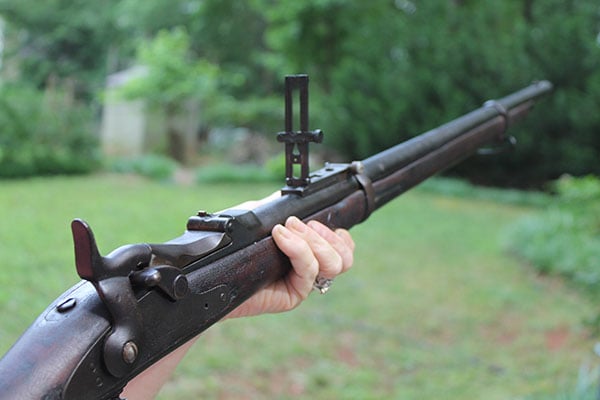
Another issue was the copper held in leather carriers created a green film that would effectively weld the case into the breech of the carbine when fired. The rifle was originally issued with a copper cartridge case and used in the American West during the second half of the 19th century, but the soldiers soon discovered that the copper expanded excessively in the breech upon firing. This cartridge had a correspondingly reduced muzzle velocity of 1,100 feet per second (340 m/s) and a somewhat reduced effective range. A reduced-power load of 55 grains (3.6 g) of powder (Carbine Load) was manufactured for use in the carbine to lighten recoil for mounted cavalry soldiers. It had a muzzle velocity of 1,350 feet per second (410 m/s), making it a powerful and effective load for the skirmish tactics of the era. The rifle cartridge was designated as ".45-70-405", indicating a. 99 Springfield" which became the Model 1873. Firing tests were held at the Springfield Armory and Governor's Island where the average rate of fire for the Springfield was 8 rounds per minute for new recruits and 15 rounds per minute for experienced soldiers. Both single shot and magazine equipped systems were considered but, at the time, the single shot was deemed to be more reliable. The trials included tests for accuracy, dependability, rate-of-fire, and ability to withstand adverse conditions.
#Us model 1873 springfield trapdoor trial#
Terry, conducted an examination and trial of 99 rifles from several domestic and foreign manufacturers including those from Springfield, Sharps, Peabody, Whitney, Spencer, Remington, and Winchester pursuant to the selection of a breech-loading system for rifles and carbines for the U.S.

In 1872–1873 a military board, headed by Brigadier-General Alfred H. It was superseded by an improved model, the Springfield Model 1884, also in. The infantry rifle model featured a 32 5⁄ 8-inch (829 mm) barrel, while the cavalry carbine used a 22-inch (560 mm) barrel. The Model 1873 was the fifth variation of the Allin trapdoor design, and was named for its hinged breechblock, which opened like a trapdoor. The gun, in both full-length and carbine versions, was widely used in subsequent battles against Native Americans. The Springfield Model 1873 was the first standard-issue breech-loading rifle adopted by the United States Army (although the Springfield Model 1866 had seen limited issue to troops along the Bozeman Trail in 1867).

User dependent usually 8 to 10 rounds per minute This is a much better than average early Model 1873 trapdoor rifle.Breech-loading rifle Springfield Model 1873Ĭavalry carbine with 22 in (560 mm) barrel, The ramrod is correct with its uncupped head. The stock has a good firing proof and light but very visible script ESA cartouche. There are no cracks or chips except for a couple of very minor chips at the lower ramrod channel.

The stock is very good with the correct long wrist and scattered issue dents and dings. The buttplate is brown with US on the tang. The lockplate is correctly marked US/SPRINGFIELD/1873 with the eagle stamped to the left of that. The lockplate and hammer retain most of their original blue. The high arch breechblock is marked MODEL/1873 /eagle stamp/crossed arrows/US.

It is equipped with the correct Model 1873 rear sight with headless attaching screws. The barrel and receiver have a smooth brown patina. The 32 5/8" round barrel has good, bright rifling with some wear and erosion.


 0 kommentar(er)
0 kommentar(er)
